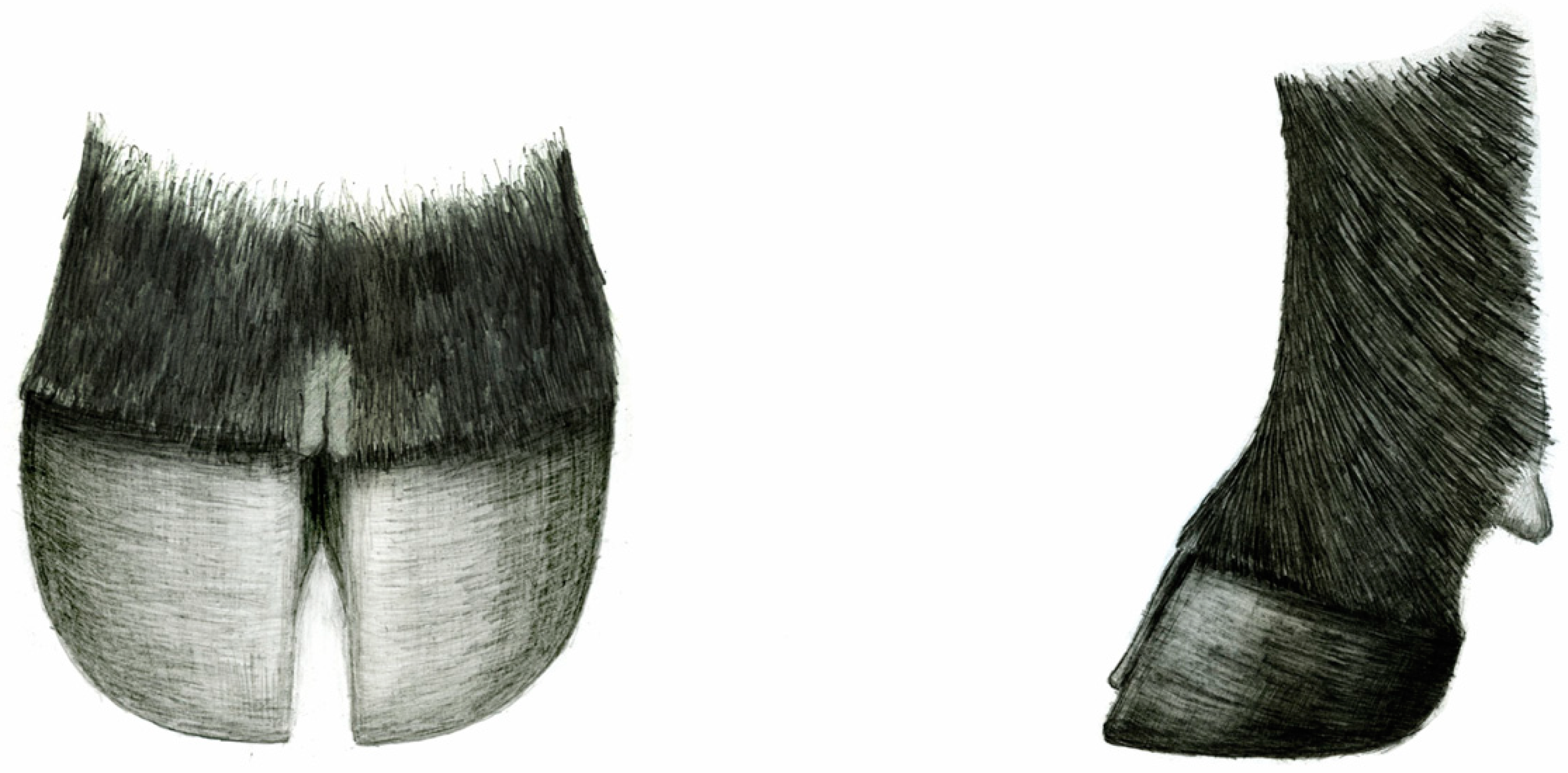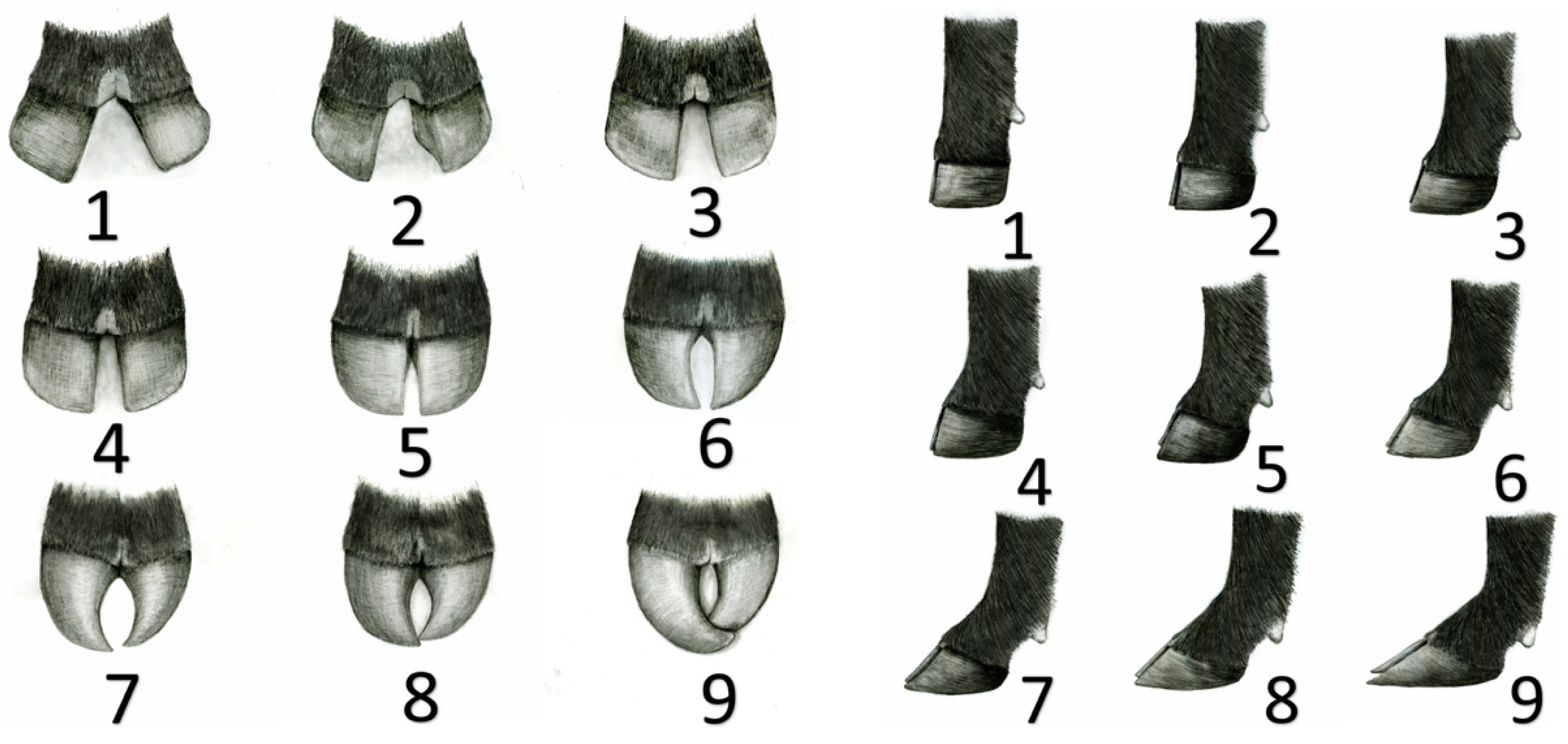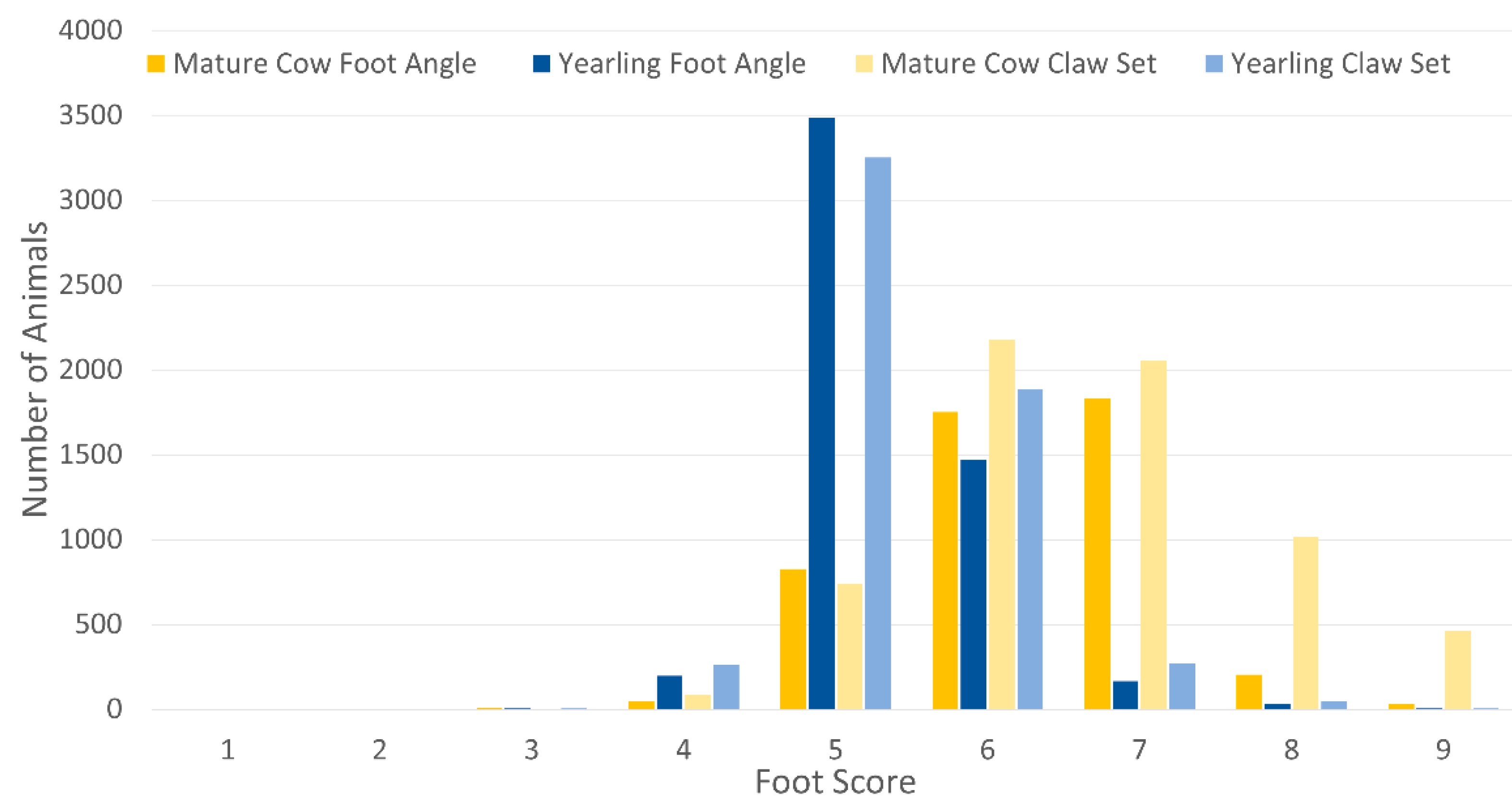Importance of Foot and Leg Structure for Beef Cattle in Forage-Based Production Systems
Abstract
Simple Summary
Abstract
1. The Bovine Foot
2. Proper Foot Conformation
3. Factors Affecting Foot Conformation and Structure
4. Importance of Quality Feet
4.1. Locomotion and Longevity
4.2. Lameness and Associated Costs
5. The Result of Years of Selection
6. The American Angus Association (AAA)
7. New Guidelines and New EPDs
8. Effect of EPDs on Cattle Selection
9. Conclusions
Supplementary Materials
Author Contributions
Funding
Institutional Review Board Statement
Informed Consent Statement
Data Availability Statement
Acknowledgments
Conflicts of Interest
References
- Zeder, M.A.; Bradley, D.G.; Smith, B.D.; Emshwiller, E. (Eds.) Documenting Domestication: New Genetic and Archaeological Paradigms; Univ. of California Press: Berkeley, CA, USA, 2006. [Google Scholar]
- Ashwood, A. Structure and Lameness. In Brahman News; Australian Brahman Breeders’ Association Limited: Rockhampton, QLD, Australia, 2011. [Google Scholar]
- Dyce, K.M.; Sack, W.O.; Wensing, C.G. Textbook of Veterinary Anatomy, 4th ed.; Saunders: St. Louis, MO, USA, 2010. [Google Scholar]
- Langova, L.; Novotna, I.; Nemcova, P.; Machacek, M.; Havlicek, Z.; Zemanova, M.; Chrast, V. Impact of Nutrients on the Hoof Health in Cattle. Animals 2020, 10, 1824. [Google Scholar] [CrossRef]
- Hahn, M.V.; McDaniel, B.; Wilk, J. Rates of hoof growth and wear in Holstein cattle. J. Dairy Sci. 1986, 69, 2148–2156. [Google Scholar] [CrossRef]
- Wheeler, J. Hoof growth: A possible index of nutrition in grazing animals. Proc. Aust. Soc. Anim. Prod. 1966, 6, 350–353. [Google Scholar]
- Tranter, W.; Morris, R. Hoof growth and wear in pasture-fed dairy cattle. N. Z. Vet. J. 1992, 40, 89–96. [Google Scholar] [CrossRef]
- Greenough, P.R.; Finlay, J.; Weaver, A. Lameness in Cattle, 2nd ed.; John Wright PSG Inc.: Littleton, MA, USA, 1981. [Google Scholar]
- Clark, A.; Rakes, A. Effect of methionine hydroxy analog supplementation on dairy cattle hoof growth and composition. J. Dairy Sci. 1982, 65, 1493–1502. [Google Scholar] [CrossRef]
- Vermunt, J.J.; Greenough, P.R. Structural characteristics of the bovine claw: Horn growth and wear, horn hardness and claw conformation. Br. Vet. J. 1995, 151, 157–180. [Google Scholar] [CrossRef]
- Boggs, D.L.; Merkel, R.A.; Doumit, M.E.; Bruns, K. Livestock & Carcasses: An Integrated Approach to Evaluation, Grading, and Selection, 6th ed.; Kendall/Hunt Publishing Company: Dubuque, IA, USA, 2006; p. 251. [Google Scholar]
- Daniel, D.L., Jr.; Kriese-Anderson, L. Beef Conformation Basics; Alabama A&M & Auburn Universities Extension: Huntsville, AL, USA, 2018. [Google Scholar]
- Wolfe, D.F. Review: Abnormalities of the bull—Occurrence, diagnosis and treatment of abnormalities of the bull, including structural soundness. Animal 2018, 12, s148–s157. [Google Scholar] [CrossRef]
- Beeson, W.M.; Hunsley, R.E.; Nordby, J.E. Beef Cattle. In Livestock Judging and Evaluation: A Handbook for the Student; INTERSTATE Printers & Publishers Inc.: The Danville, IL, USA, 1970. [Google Scholar]
- Hahn, M.V.; McDaniel, B.; Wilk, J. Genetic and Environmental Variation of Hoof Characteristics of Holstein Cattle. J. Dairy Sci. 1984, 67, 2986–2998. [Google Scholar] [CrossRef]
- Aiello, S.E.; Moses, M.A.; Allen, D.G. (Eds.) The Merck Veterinary Manual, 11th ed.; Merck & Company Incorporated: White Station, NJ, USA, 2016. [Google Scholar]
- Radke, A. Collecting Foot Scores for Improved Structure; The Fence Post: Greeley, CO, USA, 2018. [Google Scholar]
- Ral, G. Hoof and leg traits in dairy cattle. In Proceedings of the VIth International Symposium on Disorders of the Ruminant Digit, The British Cattle Veterinary Association/University of Liverpool, Liverpool, UK, 1990; pp. 219–231. [Google Scholar]
- Andersson, L.; Lundström, K. The Influence of Breed, Age, Body Weight and Season on Digital Diseases and Hoof Size in Dairy Cows 3. Zent. Veterinärmedizin Reihe A 1981, 28, 141–151. [Google Scholar] [CrossRef]
- Jensen, B.R. Genetic Parameter Estimates for Feed and Leg Traits in Red Angus. Masters’ Thesis, Kansas State University, Manhattan, KS, USA, 2017. [Google Scholar]
- Hoblet, K.H. Effects of Nutrition on Hoof Health; Proceedings: Fort Wayne, Indiana, 2000; pp. 41–48. [Google Scholar]
- Lean, I.; Westwood, C.T.; Golder, H.M.; Vermunt, J.J. Impact of nutrition on lameness and claw health in cattle. Livest. Sci. 2013, 156, 71–87. [Google Scholar] [CrossRef]
- Mülling, C.; Bragulla, H.H.; Reese, S.; Budras, K.D.; Steinberg, W. How structures in bovine hoof epidermis are influenced by nutritional factors. Anat. Histol. Embryol. 1999, 28, 103–108. [Google Scholar] [CrossRef] [PubMed]
- Puls, R. Mineral Levels in Animal Health; Diagnostic Data; Sherpa International: Darjeeling, India, 1988. [Google Scholar]
- Ballantine, H.T.; Socha, M.T.; Tomlinson, D.A.D.; Johnson, A.B.; Fielding, A.S.; Shearer, J.K.; Van Amstel, S.R. Effects of feeding complexed zinc, manganese, copper, and cobalt to late gestation and lactating dairy cows on claw integrity, reproduction, and lactation performance. Prof. Anim. Sci. 2002, 18, 211–218. [Google Scholar] [CrossRef]
- Hendry, K.A.; MacCallum, A.; Knight, C.; Wilde, C. REVIEW ARTICLE Laminitis in the dairy cow: A cell biological approach. J. Dairy Res. 1997, 64, 475–486. [Google Scholar] [CrossRef] [PubMed]
- Nocek, J.E. Bovine acidosis: Implications on laminitis. J. Dairy Sci. 1997, 80, 1005–1028. [Google Scholar] [CrossRef]
- Greenough, P.R. Bovine Laminitis and Lameness–A Hands on Approach; Saunders Elsevier: Philadelphia, PA, USA, 2007; pp. 8–304. [Google Scholar]
- Elam, C. Acidosis in feedlot cattle: Practical observations. Anim. Sci. J. 1976, 43, 898–901. [Google Scholar] [CrossRef]
- Vermunt, J.P. Greenough, Predisposing factors of laminitis in cattle. Brit. Vet. J. 1994, 150, 151–164. [Google Scholar] [CrossRef]
- Allenstein, L.C. Lamenesses of cattle. Can. Vet. J. 1981, 22, 65. [Google Scholar]
- Biggs, R.; Whitworth, B.; Gilliam, J.; Jones, M.; Lalman, D. Foot Rot in Cattle. 2016. Available online: https://extension.okstate.edu/fact-sheets/foot-rot-in-cattle.html (accessed on 18 September 2022).
- Tunstall, J. Lameness in Beef Cattle: Establishing a Knowledge Base. Ph.D. Thesis, Veterinary Medicine, University of Liverpool, UK, 2020. [Google Scholar]
- Newcomer, B.W.; Chamorro, M.F. Distribution of lameness lesions in beef cattle: A retrospective analysis of 745 cases. Can. Vet. J. 2016, 57, 401. [Google Scholar]
- Fjeldaas, T.; Nafstad, O.; Fredriksen, B.; Ringdal, G.; Sogstad, Å.M. Claw and limb disorders in 12 Norwegian beef-cow herds. Acta Vet. Scand. 2007, 49, 24. [Google Scholar] [CrossRef]
- Goonewardene, L.; Hand, R. A study of hoof cracks in grazing cattle—Association of age, weight and fatness. Can. J. Anim. Sci. 1995, 75, 25–29. [Google Scholar] [CrossRef]
- Wang, L.; Miller, S.P.; Retallick, K.J.; Moser, D.W. Genetic parameter estimation for foot structure in American Angus cattle. J. Anim. Sci. 2017, 95, 100. [Google Scholar] [CrossRef]
- Mettlen, S. Staying Sound. In Angus Beef Bulletin Extra; American Angus Association: Saint Joseph, MO, USA, 2019. [Google Scholar]
- Jeyaruban, G.; Tier, B.; Johnston, D.; Graser, H. Genetic analysis of feet and leg traits of Australian Angus cattle using linear and threshold models. Anim. Prod. Sci. 2012, 52, 1–10. [Google Scholar] [CrossRef]
- Gard, J.A.; van Santen, E. Effect of exercise and environmental terrain on development of the digital cushion and bony structures of the bovine foot. Am. J. Vet. Res. 2015, 76, 246–252. [Google Scholar] [CrossRef]
- Van Dorp, T.E.; Boettcher, P.; Schaeffer, L. Genetics of locomotion. Livest. Prod. Sci. 2004, 90, 247–253. [Google Scholar] [CrossRef]
- Wyffels, S.A.; Boss, D.L.; Sowell, B.F.; DelCurto, T.; Bowman, J.G.; McNew, L.B. Dormant season grazing on northern mixed grass prairie agroecosystems: Does protein supplement intake, cow age, weight and body condition impact beef cattle resource use and residual vegetation cover? PLoS ONE 2020, 15, e0240629. [Google Scholar] [CrossRef]
- NASS. Farms and Land in Farms 2019 Summary. 2020; pp. 5–6. Available online: https://www.nass.usda.gov/Publications/Todays_Reports/reports/fnlo0220.pdf (accessed on 7 May 2022).
- Putnam, D.H.; DelCurto, T. Forage Systems for Arid Areas. Forages Sci. Grassl. Agric. 2020, 2, 433–451. [Google Scholar] [CrossRef]
- Anderson, D.M.; Kothmann, M. Relationship of Distance Traveled with Diet and Weather for Hereford Heifers. J. Range Manag. 1980, 33, 217–220. [Google Scholar] [CrossRef]
- Cory, V.L. Activities of Livestock on the Range; Texas Agricultural Experiment Station: College Station, TX, USA, 1927. [Google Scholar]
- Walburger, K.J.; Wells, M.; Vavra, M.; DelCurto, T.; Johnson, B.; Coe, P. Influence of Cow Age on Grazing Distribution in a Mixed-Conifer Forest. Rangel. Ecol. Manag. 2009, 62, 290–296. [Google Scholar] [CrossRef]
- Parsons, C.; Momont, P.; DelCurto, T.; McInnis, M.; Porath, M.L. Cattle Distribution Patterns and Vegetation Use in Mountain Riparian Areas. J. Range Manag. 2003, 56, 334–341. [Google Scholar] [CrossRef]
- Roath, L.R.; Krueger, W.C. Cattle Grazing and Behavior on a Forested Range. J. Range Manag. 1982, 35, 332–338. [Google Scholar] [CrossRef]
- Allred, B.W.; Fuhlendorf, R.G. Hamilton, The role of herbivores in Great Plains conservation: Comparative ecology of bison and cattle. Ecosphere 2011, 2, 1–17. [Google Scholar] [CrossRef]
- Kohl, M.T.; Krausman, P.R.; Kunkel, K.; Williams, D.M. Bison Versus Cattle: Are They Ecologically Synonymous? Rangel. Ecol. Manag. 2013, 66, 721–731. [Google Scholar] [CrossRef]
- Bailey, D.W.; VanWagoner, H.; Weinmeister, R. Individual Animal Selection Has the Potential to Improve Uniformity of Grazing on Foothill Rangeland. Rangel. Ecol. Manag. 2006, 59, 351–358. [Google Scholar] [CrossRef]
- Pauling, R.C.; Speidel, S.E.; Thomas, M.G.; Holt, T.N.; Enns, R.M. Evaluation of moderate to high elevation effects on pulmonary arterial pressure measures in Angus cattle. J. Anim. Sci. 2018, 96, 3599–3605. [Google Scholar] [CrossRef]
- Holt, T.N.; Callan, R.J. Pulmonary arterial pressure testing for high mountain disease in cattle. Vet. Clin. North Am. Food Anim. Pract. 2007, 23, 575–596. [Google Scholar] [CrossRef]
- Ramsey, R.; Doye, D.; Ward, C.; McGrann JFalconer, L.; Bevers, S. Factors Affecting Beef Cow-Herd Costs, Production, and Profits. J. Agric. Appl. Econ. 2005, 37, 91–99. [Google Scholar] [CrossRef]
- McFarlane, Z.D.; Boyer, C.; Mulliniks, J.T. Profitability of Developing Beef Heifers on Stockpiled Winter Forages. J. Appl. Farm Econ. 2018, 2, 1. [Google Scholar] [CrossRef]
- Giess, L.K. Development of a Feet and Leg Scoring Method and Selection Tool for Improved Soundness in Red Angus Cattle. Masters’ Thesis, Kansas State University, Manhattan, KS, USA, 2017. [Google Scholar]
- Cundiff, L.V.; Nunez-Dominguez, R.; Dickerson, G.E.; Gregory, K.E.; Koch, R.M. Heterosis for lifetime production in Hereford, Angus, Shorthorn, and crossbred cows. J. Anim. Sci. 1992, 70, 2397–2410. [Google Scholar] [CrossRef]
- Forabosco, F.; Groen, A.F.; Bozzi, R.; Van Arendonk JA, M.; Filippini, F.; Boettcher, P.; Bijma, P. Phenotypic relationships between longevity, type traits, and production in Chianina beef cattle. J. Anim. Sci. 2004, 82, 1572–1580. [Google Scholar] [CrossRef]
- Giess, L.K.; Jensen, B.R.; Bormann, J.M.; Rolf, M.M.; Weaber, R.L. Genetic parameter estimates for feet and leg traits in Red Angus cattle. J. Anim. Sci. 2021, 99, skab256. [Google Scholar] [CrossRef]
- Gadberry, S.; Jennings, J.; Ward, H.; Beck, P.; Kutz, B. Troxel, University of Arkansas Research and Extension. Beef cattle production. 2016. Available online: https://www.uaex.uada.edu/publications/pdf/mp184/MP184.pdf (accessed on 10 May 2022).
- Bruijnis, M.R.N.; Hogeveen, H.; Stassen, E. Assessing economic consequences of foot disorders in dairy cattle using a dynamic stochastic simulation model. J. Dairy Sci. 2010, 93, 2419–2432. [Google Scholar] [CrossRef] [PubMed]
- Ritchie, H. Harlan Ritchie’s Brief History of Cattle Type; Cutrer, B.R., Ed.; Ranch House Designs: Wharton, TX, USA, 2012. [Google Scholar]
- Kock, R.; Algeo, J. The beef cattle industry: Changes and challenges. J. Anim. Sci. 1983, 57 (Suppl. S2), 28–43. [Google Scholar]
- Baltz, T.C.; Goodwin, J.W.; Brown, A., Jr. A review and analysis of beef carcass weight increases: Economic, biological, and industry relationships. Prof. Anim. Sci. 1992, 8, 46–52. [Google Scholar] [CrossRef]
- Cross, H.R.; Savell, J.; Francis, J.J. National Consumer Retail Beef Study. In 39th Reciprocal Meat Conference; American Meat Science Association: Champaign, IL, USA, 1986. [Google Scholar]
- AAA. Frame Score. 2022 [Cited 2022 May 2]; Adapted from the BIF Guidelines for Uniform Beef Improvement]. Available online: https://www.angus.org/performance/Framescore (accessed on 2 May 2022).
- McMurray, M. Just how big are our beef cows these days? Feedstuffs 2008, 80, 16–17. [Google Scholar]
- NRC. Nutrient Requirements of Beef Cattle; National Academy Press: Washington, DC, USA, 1996. [Google Scholar]
- Beck, P.A.; Stewart, C.B.; Gadberry, M.S.; Haque, M.; Biermacher, J. Effect of mature body weight and stocking rate on cow and calf performance, cow herd efficiency, and economics in the southeastern United States. J. Anim. Sci. 2016, 94, 1689–1702. [Google Scholar] [CrossRef] [PubMed]
- Scasta, J.D.; Henderson, L.; Smith, T. Drought effect on weaning weight and efficiency relative to cow size in semiarid rangeland. J. Anim. Sci. 2015, 93, 5829–5839. [Google Scholar] [CrossRef]
- Capper, J.L. The environmental impact of beef production in the United States: 1977 compared with 2007. J. Anim. Sci. 2011, 89, 4249–4261. [Google Scholar] [CrossRef]
- Peel, D.S.J.A. How We Got Here: A Brief History of Cattle and Markets. In FEEDLOT; Feedlot Magazine: Dighton, KS, USA, 2022. [Google Scholar]
- USDA. Beef 2007-08, Part III: Changes to the U.S. Beef Cow-Calf Industry, 1993–2008; CEAH: Fort Collins, CO, USA, 2008. [Google Scholar]
- Retallick, K.J. New Foot Structure EPDs: Claw Set and Foot Angle. Angus J. 2019. [Google Scholar]
- Angus University Webinars. Facts about Foot Scoring, K. Retallick. Webinar. 2020. Available online: https://www.youtube.com/watch?v=XdkTZzLeqw8 (accessed on 29 April 2022).
- Holstein Association USA. Linear Type Evaluations. 2022. Available online: https://www.holsteinusa.com/genetic_evaluations/ss_linear.html (accessed on 24 May 2022).
- Burke, B.P.; Funk, D.A. Relationship of linear type traits and herd life under different management systems. J. Anim. Sci. 1993, 76, 2773–2782. [Google Scholar] [CrossRef]
- Kossaibati, M.A.; Esslemont, R.J. The costs of production diseases in dairy herds in England. Vet. J. 1997, 154, 41–51. [Google Scholar] [CrossRef]
- Garvey, M. Lameness in Dairy Cow Herds: Disease Aetiology, Prevention and Management. Dairy 2022, 3, 199–210. [Google Scholar] [CrossRef]
- Detweiler, R.A.; Pringle, T.D.; Rekaya, R.; Wells, J.B.; Segers, J.R. The impact of selection using residual average daily gain and marbling EPDs on growth, performance, and carcass traits in Angus steers 1. J. Anim. Sci. 2019, 97, 2450–2459. [Google Scholar] [CrossRef] [PubMed]
- Van Eenennaam, A.L. Improving EPD accuracy by combining EPD information with DNA test results. In Proceedings of the Applied Reproductive Strategies in Beef Cattle Conference, Joplin, MO, USA, 31 August–1 September 2011. [Google Scholar]




| Trait | Model 1 | Heritability | References |
|---|---|---|---|
| Front foot angle | LAM | 0.17–0.32 | [17] |
| Rear foot angle | LAM | 0.18–0.29 | [39] |
| TAM | 0.26–0.35 | [39] | |
| Front claw shape | LAM | 0.22–0.33 | [39] |
| Rear claw shape | LAM | 0.16–0.29 | [39] |
| Rear leg side view | LAM | 0.10–0.21 | [39] |
| TAM | 0.16–0.22 | [39] | |
| Rear leg rear view | LAM | 0.16–0.15 | [39] |
| TAM | 0.12–0.32 | [39] | |
| LAM | 0.34 | [37] | |
| Foot angle | LAM | 0.21 | [37] |
| Claw set | LAM | 0.16 | [37] |
| Spread (divergent toes) Scissors (curled over toes) | LAM | 0.25 | [37] |
| Steep angle | LAM | 0.22 | [37] |
| Weak angle | LAM | 0.37 | [37] |
Disclaimer/Publisher’s Note: The statements, opinions and data contained in all publications are solely those of the individual author(s) and contributor(s) and not of MDPI and/or the editor(s). MDPI and/or the editor(s) disclaim responsibility for any injury to people or property resulting from any ideas, methods, instructions or products referred to in the content. |
© 2023 by the authors. Licensee MDPI, Basel, Switzerland. This article is an open access article distributed under the terms and conditions of the Creative Commons Attribution (CC BY) license (https://creativecommons.org/licenses/by/4.0/).
Share and Cite
Sitz, T.; DelCurto-Wyffels, H.; Van Emon, M.; Wyffels, S.; Retallick, K.; Tarpoff, E.; Kangas, K.; DelCurto, T. Importance of Foot and Leg Structure for Beef Cattle in Forage-Based Production Systems. Animals 2023, 13, 495. https://doi.org/10.3390/ani13030495
Sitz T, DelCurto-Wyffels H, Van Emon M, Wyffels S, Retallick K, Tarpoff E, Kangas K, DelCurto T. Importance of Foot and Leg Structure for Beef Cattle in Forage-Based Production Systems. Animals. 2023; 13(3):495. https://doi.org/10.3390/ani13030495
Chicago/Turabian StyleSitz, Taylre, Hannah DelCurto-Wyffels, Megan Van Emon, Sam Wyffels, Kelli Retallick, Esther Tarpoff, Kurt Kangas, and Tim DelCurto. 2023. "Importance of Foot and Leg Structure for Beef Cattle in Forage-Based Production Systems" Animals 13, no. 3: 495. https://doi.org/10.3390/ani13030495
APA StyleSitz, T., DelCurto-Wyffels, H., Van Emon, M., Wyffels, S., Retallick, K., Tarpoff, E., Kangas, K., & DelCurto, T. (2023). Importance of Foot and Leg Structure for Beef Cattle in Forage-Based Production Systems. Animals, 13(3), 495. https://doi.org/10.3390/ani13030495





